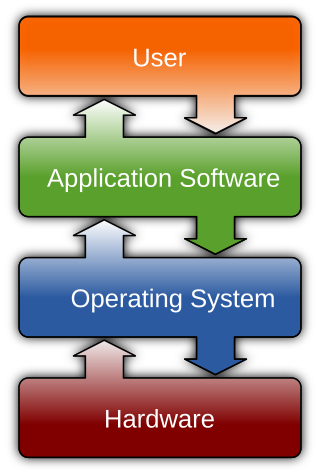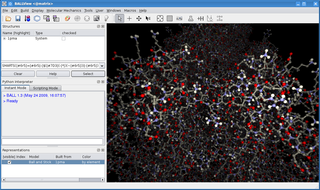Related Research Articles

Software is a collection of programs and data that tell a computer how to perform specific tasks. Software often includes associated software documentation. This is in contrast to hardware, from which the system is built and which actually performs the work.
In computing, Common Gateway Interface (CGI) is an interface specification that enables web servers to execute an external program to process HTTP or HTTPS user requests.
In computing, cross-platform software is computer software that is designed to work in several computing platforms. Some cross-platform software requires a separate build for each platform, but some can be directly run on any platform without special preparation, being written in an interpreted language or compiled to portable bytecode for which the interpreters or run-time packages are common or standard components of all supported platforms.

A web application is application software that is accessed using a web browser. Web applications are delivered on the World Wide Web to users with an active network connection.
Web development is the work involved in developing a website for the Internet or an intranet. Web development can range from developing a simple single static page of plain text to complex web applications, electronic businesses, and social network services. A more comprehensive list of tasks to which Web development commonly refers, may include Web engineering, Web design, Web content development, client liaison, client-side/server-side scripting, Web server and network security configuration, and e-commerce development.
ScientificPython is an open source library of scientific tools for the Python programming language. Its development started in 1995.
The Web Server Gateway Interface is a simple calling convention for web servers to forward requests to web applications or frameworks written in the Python programming language. The current version of WSGI, version 1.0.1, is specified in Python Enhancement Proposal (PEP) 3333.
A GIS software program is a computer program to support the use of a geographic information system, providing the ability to create, store, manage, query, analyze, and visualize geographic data, that is, data representing phenomena for which location is important. The GIS software industry encompasses a broad range of commercial and open-source products that provide some or all of these capabilities within various information technology architectures.
In computing, a solution stack or software stack is a set of software subsystems or components needed to create a complete platform such that no additional software is needed to support applications. Applications are said to "run on" or "run on top of" the resulting platform.
A problem solving environment (PSE) is a completed, integrated and specialised computer software for solving one class of problems, combining automated problem-solving methods with human-oriented tools for guiding the problem resolution. A PSE may also assist users in formulating problem resolution. A PSE may also assist users in formulating problems, selecting algorithm, simulating numerical value and viewing and analysing results.

BALL is a C++ class framework and set of algorithms and data structures for molecular modelling and computational structural bioinformatics, a Python interface to this library, and a graphical user interface to BALL, the molecule viewer BALLView.
Web-based simulation (WBS) is the invocation of computer simulation services over the World Wide Web, specifically through a web browser. Increasingly, the web is being looked upon as an environment for providing modeling and simulation applications, and as such, is an emerging area of investigation within the simulation community.

Kivy is a free and open source Python framework for developing mobile apps and other multitouch application software with a natural user interface (NUI). It is distributed under the terms of the MIT License, and can run on Android, iOS, Linux, macOS, and Windows.

RStudio is an integrated development environment for R, a programming language for statistical computing and graphics. It is available in two formats: RStudio Desktop is a regular desktop application while RStudio Server runs on a remote server and allows accessing RStudio using a web browser. The RStudio IDE is a product of Posit PBC.

Anaconda is a distribution of the Python and R programming languages for scientific computing, that aims to simplify package management and deployment. The distribution includes data-science packages suitable for Windows, Linux, and macOS. It is developed and maintained by Anaconda, Inc., which was founded by Peter Wang and Travis Oliphant in 2012. As an Anaconda, Inc. product, it is also known as Anaconda Distribution or Anaconda Individual Edition, while other products from the company are Anaconda Team Edition and Anaconda Enterprise Edition, neither of which are free.

A notebook interface or computational notebook is a virtual notebook environment used for literate programming, a method of writing computer programs. Some notebooks are WYSIWYG environments including executable calculations embedded in formatted documents; others separate calculations and text into separate sections. Notebooks share some goals and features with spreadsheets and word processors but go beyond their limited data models.

Project Jupyter is a project to develop open-source software, open standards, and services for interactive computing across multiple programming languages.
References
- ↑ "Shiny: Web Application Framework for R". 5 August 2023.
- ↑ Doi, Jimmy; Potter, Gail; Wong, Jimmy; Alcaraz, Irvin; Chi, Peter (2016). "Web Application Teaching Tools for Statistics Using R and Shiny". Technology Innovations in Statistics Education. 9 (1). doi: 10.5070/T591027492 .
- 1 2 3 4 Kasprzak, Peter; Mitchell, Lachlan; Kravchuk, Olena; Timmins, Andy (2020). "Six Years of Shiny in Research - Collaborative Development of Web Tools in R" (PDF). The R Journal . 12 (2): 20–42. doi:10.32614/RJ-2021-004. S2CID 231709443 . Retrieved 12 March 2022.
- ↑ Li, Yu (2020). "Towards fast prototyping of cloud-based environmental decision support systems for environmental scientists using R Shiny and Docker". Environmental Modelling & Software . 132: 104797. doi:10.1016/j.envsoft.2020.104797. hdl: 20.500.11850/431312 . S2CID 221823072.
- ↑ "Shiny for Python". shiny.rstudio.com. Retrieved 2023-01-30.
- ↑ "Shiny for Python - Shinylive: Shiny + WebAssembly". shiny.rstudio.com. Retrieved 2023-01-30.
- ↑ Kaufman, Aaron R. (30 April 2020). "Implementing novel, flexible, and powerful survey designs in R Shiny". PLOS ONE. 15 (4): e0232424. Bibcode:2020PLoSO..1532424K. doi: 10.1371/journal.pone.0232424 . PMC 7192460 . PMID 32353057.
- ↑ "shinyapps.io". www.shinyapps.io. Retrieved 2022-05-24.
